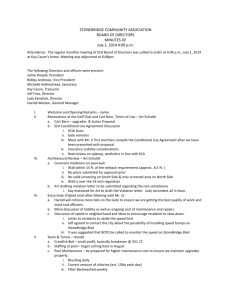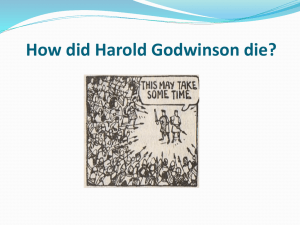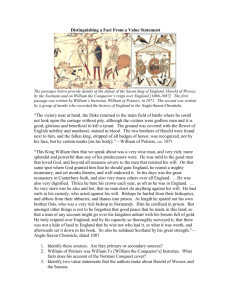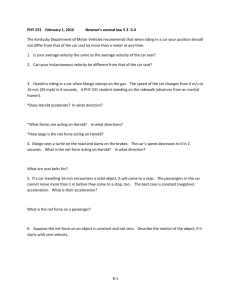ch_19_Case Study 2_Answer_Key
advertisement
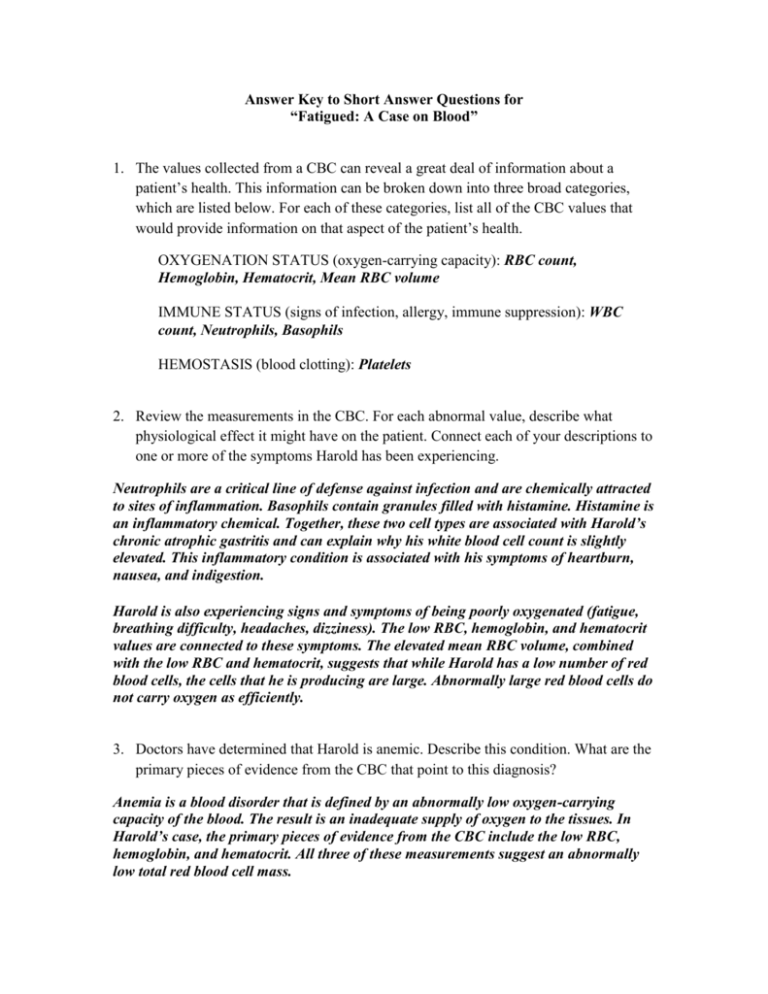
Answer Key to Short Answer Questions for “Fatigued: A Case on Blood” 1. The values collected from a CBC can reveal a great deal of information about a patient’s health. This information can be broken down into three broad categories, which are listed below. For each of these categories, list all of the CBC values that would provide information on that aspect of the patient’s health. OXYGENATION STATUS (oxygen-carrying capacity): RBC count, Hemoglobin, Hematocrit, Mean RBC volume IMMUNE STATUS (signs of infection, allergy, immune suppression): WBC count, Neutrophils, Basophils HEMOSTASIS (blood clotting): Platelets 2. Review the measurements in the CBC. For each abnormal value, describe what physiological effect it might have on the patient. Connect each of your descriptions to one or more of the symptoms Harold has been experiencing. Neutrophils are a critical line of defense against infection and are chemically attracted to sites of inflammation. Basophils contain granules filled with histamine. Histamine is an inflammatory chemical. Together, these two cell types are associated with Harold’s chronic atrophic gastritis and can explain why his white blood cell count is slightly elevated. This inflammatory condition is associated with his symptoms of heartburn, nausea, and indigestion. Harold is also experiencing signs and symptoms of being poorly oxygenated (fatigue, breathing difficulty, headaches, dizziness). The low RBC, hemoglobin, and hematocrit values are connected to these symptoms. The elevated mean RBC volume, combined with the low RBC and hematocrit, suggests that while Harold has a low number of red blood cells, the cells that he is producing are large. Abnormally large red blood cells do not carry oxygen as efficiently. 3. Doctors have determined that Harold is anemic. Describe this condition. What are the primary pieces of evidence from the CBC that point to this diagnosis? Anemia is a blood disorder that is defined by an abnormally low oxygen-carrying capacity of the blood. The result is an inadequate supply of oxygen to the tissues. In Harold’s case, the primary pieces of evidence from the CBC include the low RBC, hemoglobin, and hematocrit. All three of these measurements suggest an abnormally low total red blood cell mass. 4. Chronic atrophic gastritis is a condition that leads to the degradation of the lining of the stomach. Based on Harold’s history of this form of gastritis, his doctor also ordered tests to check the levels of vitamin B12 in his blood. How might Harold’s gastritis affect these levels? The stomach mucosa produces a substance called intrinsic factor. This substance is critical for the normal absorption of vitamin B12. Damage to the stomach mucosa, caused by Harold’s chronic inflammatory condition, can have an inhibitory effect on the production of intrinsic factor and the subsequent absorption of this important vitamin. Vitamin B12 is important for the normal development of red blood cells. 5. There are many different types of anemia. Which specific type of anemia is Harold suffering from? Beginning with the peripheral blood smear, describe the key pieces of evidence you’ve used to draw this conclusion. Harold is suffering from a condition called pernicious anemia. This form of anemia is caused by impaired uptake of vitamin B12 as a result of a lack of intrinsic factor produced by the stomach mucosa, which in Harold’s case has been damaged by his gastritis. Low levels of B12 can be used to explain why fewer, but abnormally large, red blood cells can be seen on the peripheral blood smear. Vitamin B12 is important for the normal development of red blood cells. With low vitamin B12, red blood cells grow but do not divide during their development. The results of the CBC confirm that Harold has abnormally low numbers of red blood cells, and that the mean volume of the cells that he does produce is high. 6. What would be the treatment for Harold’s blood condition? Explain how this would help treat his symptoms. Treatment for this type of anemia involves administering vitamin B12 by intramuscular injections, pills, and/or a gel applied to the nasal mucosa. If the levels of circulating B12 can be restored, red blood cells should develop normally and help address Harold’s oxygenation issues. 7. Harold’s tachycardia and chronic gastritis are key pieces of evidence in this case that go beyond what shows up in his CBC. One is the cause of his condition and one is a result (sign). Identify which is the sign and which is the cause, and describe their relationship to his condition. Harold’s tachycardia is the result (sign) that is caused by his chronic gastritis. His gastritis impairs his ability to produce intrinsic factor and then absorb vitamin B12. The low levels of this important vitamin are responsible for his anemia. Harold’s anemia means that his tissues are poorly oxygenated. Harold’s increased heart rate (tachycardia) is his body’s response to the low oxygen.

